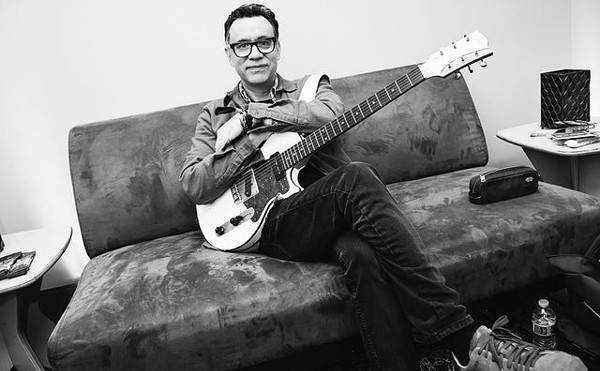In the late 1960s, artists like Dan Flavin used fluorescent light to explore the properties of a room. Flavin's placement of fluorescent lamps adjacent to or parallel to one another seemed flat-footed and obvious to some, but others were taken by the way that such lamps, unlike the conventional light bulb, which still created shadows, resulted in long straight lines of light that articulated space without shadow. Viewers were acutely aware of a dose of artificiality in exhibits by Flavin and other such artists, and that detachment was an important part of the experience. Instead of attempting to lull and seduce their audience, these artists encouraged viewers to step back and examine their own reactions.
Thurmer works within this tradition but, though his artistic syntax is sometimes similar to that of his predecessors, he has something original to say. His choice of fluorescent light, in itself, then, is inconsequential; it's how Thurmer uses that light to further his thematic concerns that determines whether his pieces deliver the goods. Young composer Michael Torke recently pulled off a similar feat in the music world, putting new twists on familiar material by fusing pop, jazz, and classical idioms into a new hybrid. And though Thurmer's essentially dark vision could not be further removed from Torke's buoyancy and optimism, he too has found a way to convincingly play the Lone Ranger, though his mask and his horse may be borrowed.
Thurmer is interested in elementals--light, fire, water, but light most of all. His installations also ask the viewer to be responsive to sensory shifts; in close succession, we are asked to listen, to see, to touch, and even to smell. Thurmer also modifies the architecture of the gallery; beneath a staircase he arranges a series of small, square mirrors in a straight line. These mirrors dovetail with the geometrical shapes of the staircase, lending the impression that the gallery has several levels that are concealed, but which the artist is showing us for the first time.
Further adding to the sense of illusion is "Light Chair (The Thousand Petaled Lotus)," a chair Thurmer has created entirely with fluorescent light tubes bound together with silicone caulking. The wires and transformers that power the display lie below in a disorganized heap. In this manner, Thurmer craftily joins an image of luminosity with one of chaos. Meanwhile, a group of nearby nondescript gallery chairs, their faded color strongly reminiscent of tacky 1960s Life magazine ads, are conspicuous for their failure to participate in Thurmer's magic act. In the manner of a medicine man or a shamanistic priest, Thurmer works with the tension between revelation and confusion, but, unlike the doctor or priest, he hesitates to offer answers and is even uncertain about whether an artist can provide solace for anyone.
Thurmer has a thematic affinity with absurdists like playwright Eugene Ionesco and film directors like Ingmar Bergman, who ponder the silence of God in modern life. People who believe that "it all turns out well in the end if you try your best" and who find Monty Python seriously unfunny had better avoid this exhibit. Even when it's tongue-in-cheek, it's liable to laugh out of the corner of its mouth--and even to snarl on occasion.
In several of his pieces, for instance, Thurmer equates light with religious faith, then gives the whole thing a sardonic twist. In one installation, a circular fluorescent light has been submerged in a plastic garbage can partially filled with water. The lid of the can is placed on an adjacent wall, and wires lead from the lid into the can. This installation confirms what is made amply clear elsewhere--that religious faith, here suggested by the halo-shaped fluorescent light, is no longer connected to the modern artist's work. The rituals of faith are mimicked, but the substance behind them is becoming increasingly inaccessible--and, as in the case of this work (should the wires lose their waterproof outer coating), even dangerous. It's risky to play around with religious conventions when the origins of those conventions are not adequately understood, Thurmer seems to be saying, and he clinches the point when he arranges a series of rectangular copper plates that bear images of fifteenth-century religious paintings on an upstairs gallery floor. We are reminded of the similarly shaped mirrors on the lower floor; the effect is to remind the viewer that the past can no longer serve as a viable stairway or bridge to the present.
Further exploring the notion of art as ritual in a non-sacred world is "The Burning Question," a television set, turned on its side and flashing the same channel ad nauseam--much like the effect one gets when the power goes out during a storm, and an alarm clock or VCR is stuck on the precise moment things went bad. Next to the tilted TV, a dozen fluorescent lights are placed parallel to one another; silicon caulking holds together a jumble of wires and transformers that provide the electrical power. You can almost smell the wires, the odor of computer components straight from the factory box. There is a sensation of heat when you stand in front of the lights--disquieting, given how tenuous that silicone caulking looks. If one of those transformers were to quit, or if one of those wires were removed, the circuit would fail, and all that light would fail. Radiance, it seems, is fragile. Next to the fluorescent lamps is a fancy picture frame that begs for some ornate allegorical painting, but that, instead, is empty; it's the cork-like gallery wall that gets all the attention.
A cyclical pattern of expectation and disappointment is set up by such works. Thurmer's light is all artifice. He conjures it by creating his own system of positive and negative charges and by using silicon caulking as a magician would use a semi-opaque cloth to conceal his tricks. Magic, unlike faith, does not depend on proof of previous success (read: miracles). And when Thurmer contrasts his dozen fluorescent lamps with the screaming TV, he pronounces the death of the connection between art and religion. He splits the two both so that he can see the bifurcation himself, and so that the viewer can then participate in the experience. The empty picture frame seems to be an acknowledgment of the artist's lack of faith in his communicative abilities. Unsure that what he is saying is worthy of such embellishment, he shares private thoughts and shuns the overtly public component of art, symbolized by the frame.
In Eugene Ionesco's play The Chairs, a delusionary old couple living alone on an island invite a group of imaginary guests to hear the old man's message to the world--a distillation of his lifetime of wisdom and experience. To give it the gravity that it deserves, he's hired a professional orator to deliver the message. Just before the big event, the old couple commit suicide--and the orator is exposed as a deaf mute.
Thurmer assumes the role of such an absurdist emcee. These installations are personal efforts to find meaning, but Thurmer doesn't suggest that any lessons drawn are easily transferred. In fact, he questions whether he has any message at all. He communicates with viewers by getting them to raise questions and to think on their own, much as Flavin and the "light artists" did back in the '60s. It's not an easy trick to pull in the realm of conceptual art, which can sometimes be austere beyond endurance. Thurmer succeeds admirably.
Installations, multimedia works by Robert Thurmer, through February 26 at the Frohring Art Gallery in the art building at Hiram College, at the intersection of state routes 82 and 700 in Hiram, 330-569-3211.











